Spider plants, scientifically known as Chlorophytum comosum, are renowned for their graceful arching leaves and air-purifying qualities, making them a popular choice for indoor plant enthusiasts. While their foliage steals much of the spotlight, spider plants also produce delicate white flowers, adding an extra layer of beauty to their appeal. However, many plant caretakers wonder: how long do spider plant flowers last? In this article, we’ll delve into the lifecycle of spider plant flowers, exploring factors that influence their longevity and offering precise answers to this common query.
Understanding Spider Plant Flowers
Before delving into the lifespan of spider plant flowers, it’s essential to understand their nature and purpose. Spider plants typically bloom during the spring and summer months, although indoor conditions can sometimes trigger flowering throughout the year. The flowers emerge on long, slender stalks, contrasting elegantly against the plant’s vibrant green foliage. Each flower consists of six petals and a central pistil, exuding a subtle fragrance that adds to their allure.
Spider plant flowers serve a crucial reproductive function. They produce pollen, attracting pollinators such as bees and butterflies. Once pollinated, the flowers give way to small, spherical seed pods containing numerous seeds. However, it’s worth noting that spider plants are primarily propagated through plantlets, or “spiderettes,” which sprout from specialized stems called stolons that dangle from the parent plant. Nonetheless, the flowers play a vital role in the plant’s lifecycle and aesthetic appeal.
Factors Influencing Flower Longevity
Several factors influence the duration of spider plant flowers, ranging from environmental conditions to plant health. Understanding these factors can help plant enthusiasts prolong the lifespan of their spider plant blooms:
1. Light Exposure: Adequate light exposure is crucial for spider plants to bloom and sustain their flowers. They thrive in bright, indirect light, although they can tolerate lower light conditions. Insufficient light may lead to weak, short-lived flowers.
2. Temperature and Humidity: Spider plants prefer moderate temperatures ranging from 65°F to 75°F (18°C to 24°C). Additionally, they appreciate moderate to high humidity levels. Extreme temperatures or dry air can stress the plant and shorten the lifespan of its flowers.
3. Watering Routine: Consistent and appropriate watering is essential for spider plant health and flowering. Overwatering can lead to root rot and other issues, while underwatering can cause stress and premature flower wilting.
4. Nutrient Availability: Spider plants benefit from regular fertilization during the growing season, typically spring and summer. Balanced fertilizers formulated for houseplants can provide essential nutrients, supporting healthy growth and blooming.
5. Pot Size and Soil Quality: Spider plants prefer slightly acidic, well-draining soil. Planting them in pots with adequate drainage holes prevents waterlogging, which can adversely affect flower longevity. Additionally, periodically repotting spider plants allows them to access fresh nutrients and space for growth.
6. Pest and Disease Management: Pests such as spider mites and mealybugs can infest spider plants, causing stress and affecting flower production. Regular inspection and prompt treatment of any pest or disease issues are crucial for maintaining plant health and prolonging flower lifespan.
7. Pruning and Maintenance: Removing spent flowers and yellowing foliage not only enhances the plant’s appearance but also redirects its energy towards producing new blooms. Pruning dead or damaged foliage promotes overall plant health and vitality.
By addressing these factors and providing optimal growing conditions, plant caretakers can extend the lifespan of spider plant flowers, allowing them to enjoy their beauty for longer periods.
Duration of Spider Plant Flowers
Now, let’s address the central question: how long do spider plant flowers last? The lifespan of spider plant flowers can vary depending on several factors, including environmental conditions and the plant’s overall health. On average, spider plant flowers typically last for 2 to 3 weeks once they bloom. However, under optimal conditions, they may persist for up to 4 weeks or occasionally longer.
During the flowering period, individual blossoms may wilt and fade after a few days, while new flowers continue to emerge, resulting in a staggered blooming pattern. This phenomenon prolongs the overall duration of flowering and ensures a continuous display of blooms throughout the season.
It’s essential to monitor the health and appearance of spider plant flowers regularly. As individual flowers begin to wither and fade, gently remove them to encourage the plant to focus its energy on producing new blossoms. Additionally, maintaining proper care practices, including watering, fertilizing, and pest management, can help sustain the vitality of the plant and extend the lifespan of its flowers.
Conclusion
Spider plant flowers add a touch of elegance and charm to any indoor space, complementing the plant’s lush foliage with delicate white blooms. While their lifespan may be relatively short compared to the plant’s overall lifecycle, understanding the factors influencing flower longevity can help plant enthusiasts maximize their enjoyment of these beautiful blossoms.
By providing optimal growing conditions, including adequate light, moderate temperatures, proper watering, and nutrient management, individuals can prolong the duration of spider plant flowers and ensure a continuous display of beauty throughout the growing season. Regular maintenance, including pruning and pest management, is essential for supporting plant health and vitality, ultimately enhancing the longevity and vibrancy of spider plant flowers.
So, the next time you marvel at the graceful arches of a spider plant, take a moment to appreciate the fleeting beauty of its delicate flowers, knowing that with proper care and attention, their presence can be enjoyed for weeks on end.


